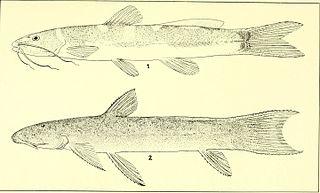
Joseph Nelson Rose was an American botanist. He was born in Union County, Indiana. His father died serving during the Civil War when Joseph Rose was a young boy. He later graduated from high school in Liberty, Indiana.

Astroblepus is a genus of fish in the family Astroblepidae found in South America and Panama. This genus is the only member of its family. These catfishes are primarily found in torrential streams in the Andean area. Astroblepus pholeter and A. riberae are troglobites adapted to living in subterranean water systems. These species are typically small, less than 10 cm (4 in). The largest species reaches 30 cm (1 ft). These fish have suckermouths like those of loricariids. They have two pairs of barbels, maxillary and nasal. The dorsal fin spine lacks a locking mechanism. These fish also have odontodes, tiny teeth on their skin. All species exhibit a conical, pointy type on their fin rays like that found in other loricarioids; other species also exhibit a blunt type that is only found on their skin.
The Andean catfish is a species of freshwater fish in the family Astroblepidae. The Spanish name for the Andean catfish is preñadilla. It is endemic to the highlands of the Ecuadorian Andes where it lives in mountain streams in four different drainage basins in the Imbakucha watershed. It is a brownish-grey fish growing to about 150 mm (6 in). The fish is threatened by human activities in the area with loss and fragmentation of its habitat, and the International Union for Conservation of Nature has assessed its conservation status as being "critically endangered".
Astroblepus eigenmanni is a species of catfish of the family Astroblepidae. It can be found on Ecuador.
Astroblepus festae is a species of catfish of the family Astroblepidae. It can be found on south Ecuador.

Astroblepus frenatus is a species of catfish of the family Astroblepidae. It can be found in the Magdalena, Orinoco and Catatumbo river basins in Colombia. A. frenatus is a carnivorous speciesand it is a habitat specialist which has a requirement for highly oxygenated water. This means that it is sensitive to changes in oxygenation levels and water temperatures. It may also be affected by the introduced rainbow trout but overall there is very little data about the status of this species.

Astroblepus grixalvii is a species of catfish of the family Astroblepidae. It can be found in Colombia and Ecuador.

Astroblepus guentheri is a carnivorous species of catfish of the family Astroblepidae. It can be found in rainforest streams in the basin of the Magdalena-Cauca rivers and in some Pacific slope rivers in Colombia. It is an uncommon and not well studied species.
Astroblepus mancoi is a species of catfish of the family Astroblepidae. It can be found on the Ucayali River on Peru.
Astroblepus mariae is a species of catfish of the family Astroblepidae. It can be found on the Meta River in Colombia and Venezuela.
Astroblepus nicefori is a species of catfish of the family Astroblepidae. It can be found of the Cauca River and the Magdalena River in Colombia.
Astroblepus phelpsi is a species of catfish of the family Astroblepidae. It can be found on Lake Maracaibo in Venezuela.
Astroblepus regani is a species of catfish of the family Astroblepidae. It can be found in Ecuador.
Astroblepus rengifoi is a species of catfish of the family Astroblepidae. It can be found on the Atrato River in Colombia.
Astroblepus riberae is a species of catfish of the family Astroblepidae. This cavefish is endemic to the Cajamarca region in Peru.
Astroblepus rosei is a species of catfish of the family Astroblepidae. It can be found on Cajamarca, Peru.
Astroblepus simonsii is a species of catfish of the family Astroblepidae. It can be found in Peru.

Astroblepus vanceae is a species of catfish of the family Astroblepidae. It can be found in the Ucayali River, Peru.

Sebastes dallii, the calico rockfish, is a species of marine ray-finned fish belonging to the subfamily Sebastinae, the rockfishes, part of the family Scorpaenidae. It is found in the eastern central Pacific Ocean.
Zaniolepis frenata, also known as the shortspine combfish, is a species of ray-finned fish belonging to the family Zaniolepididae.The species occurs in the eastern Pacific Ocean.







